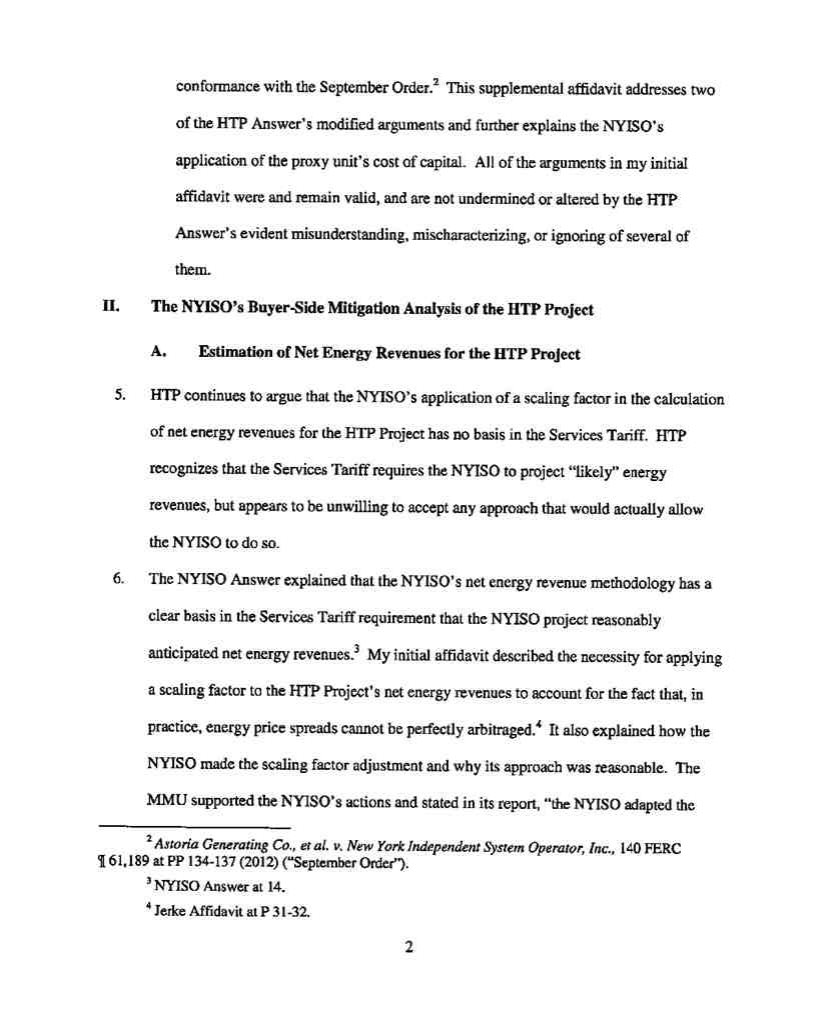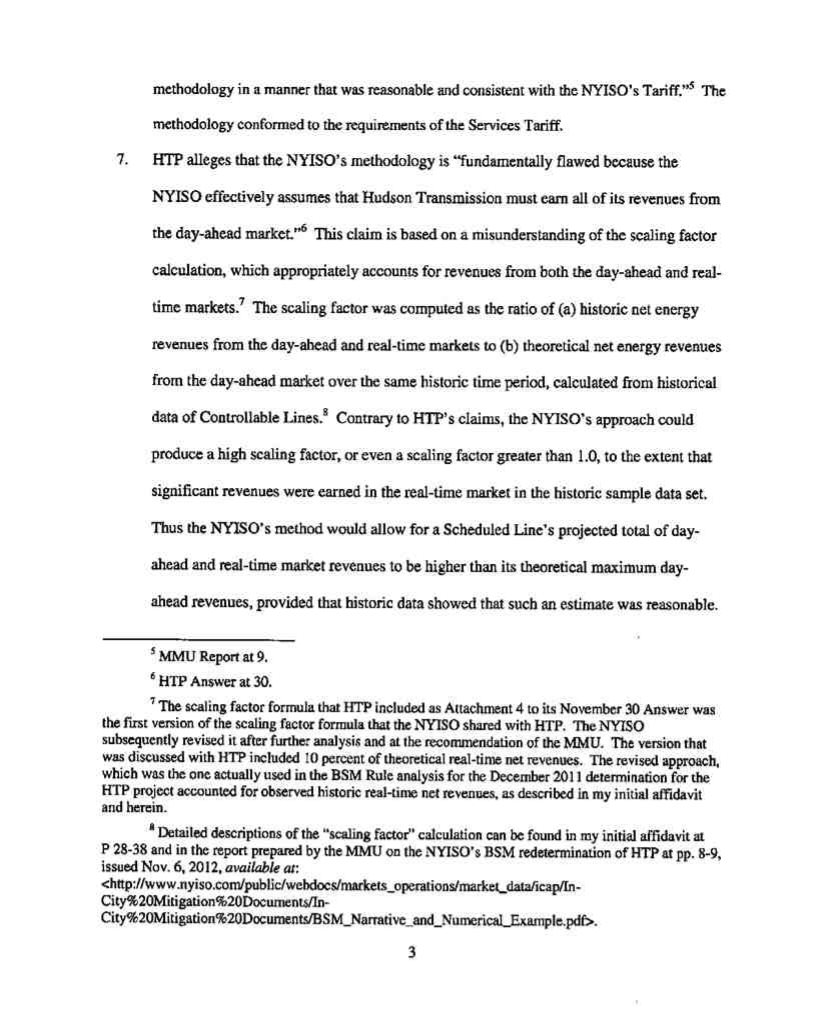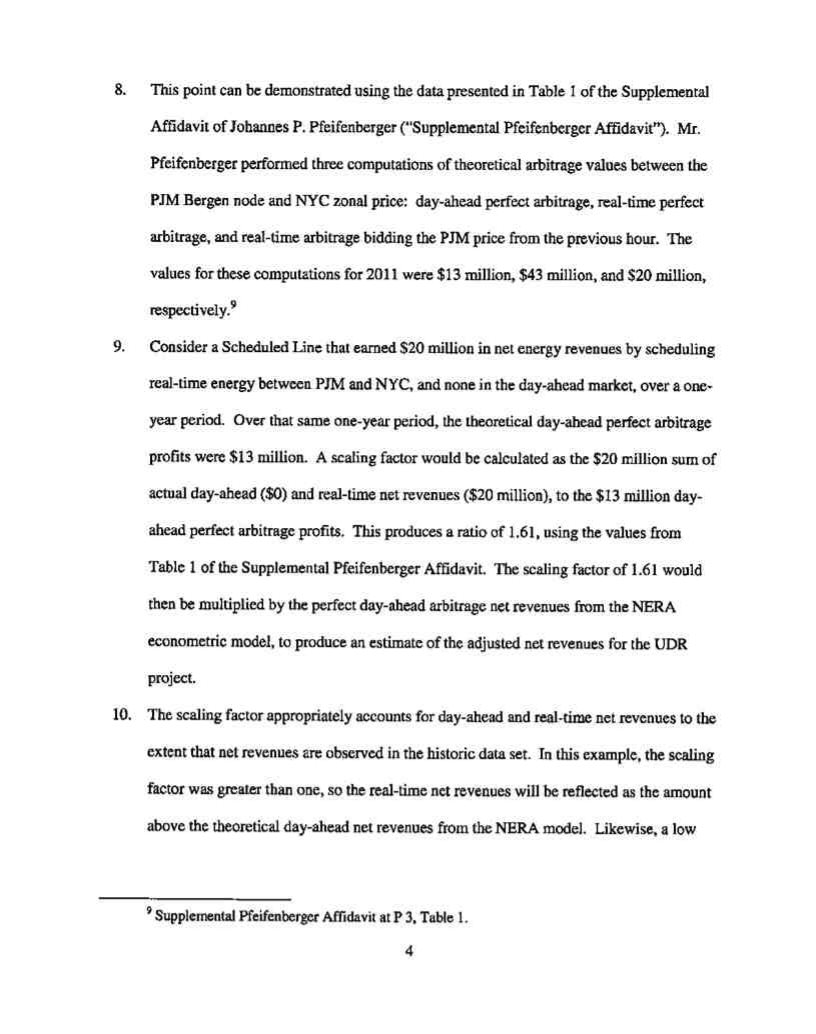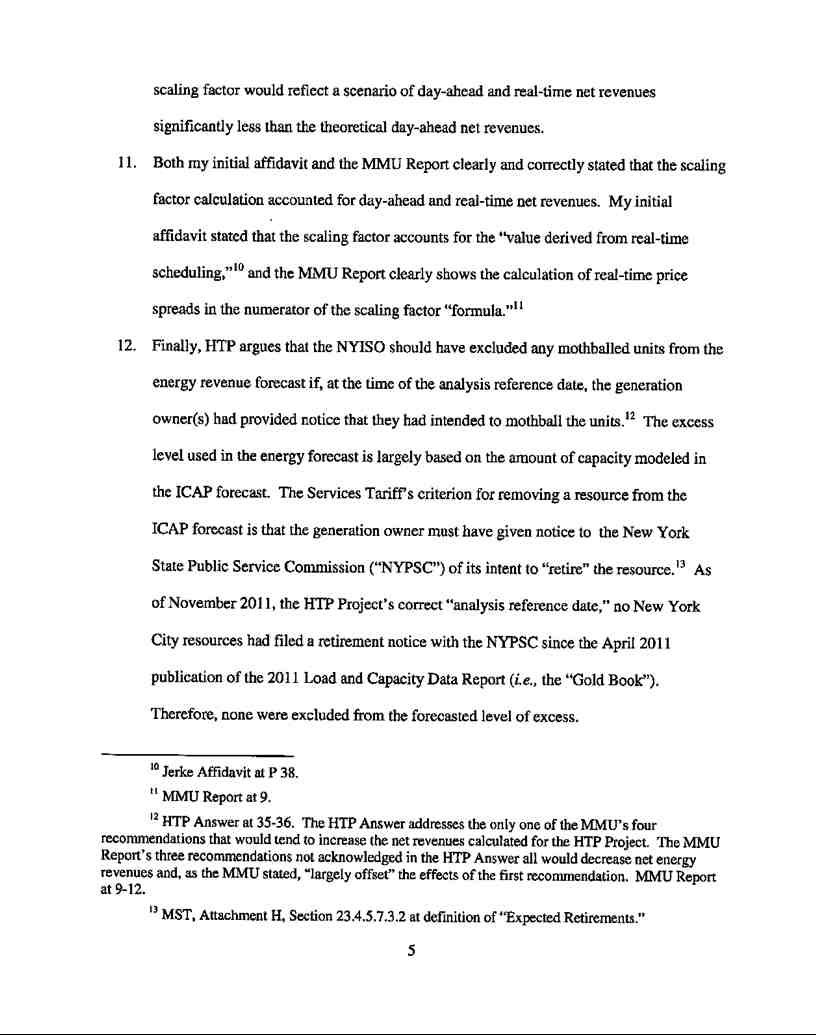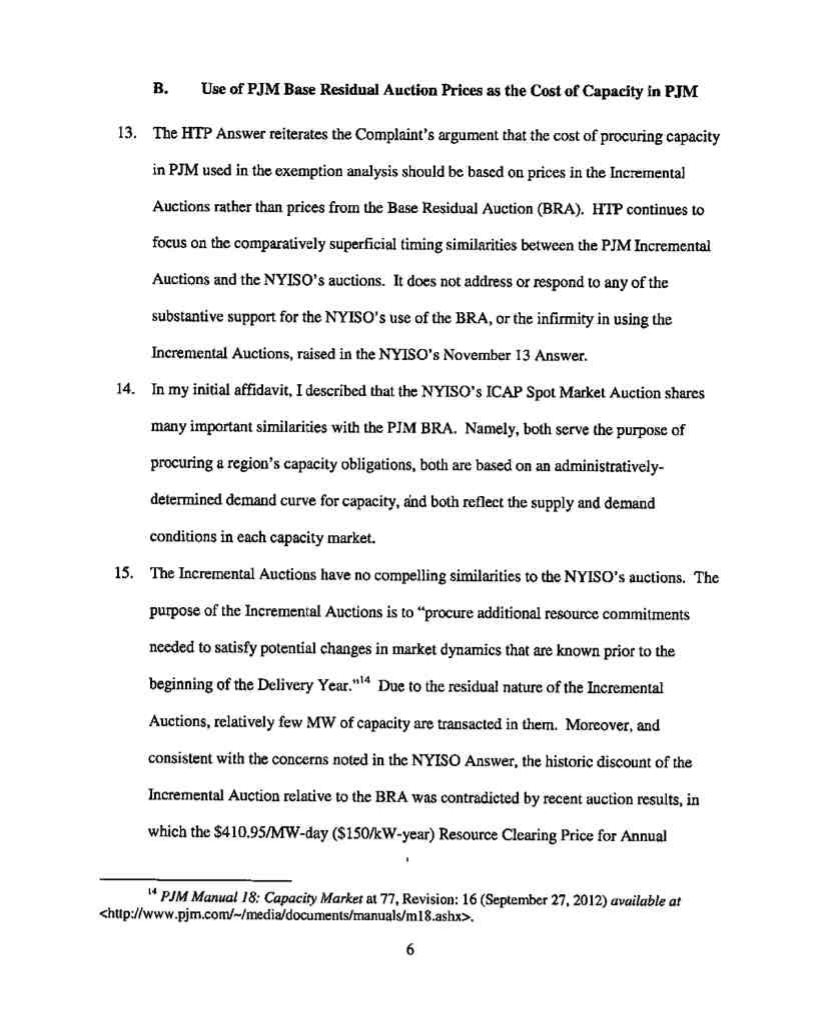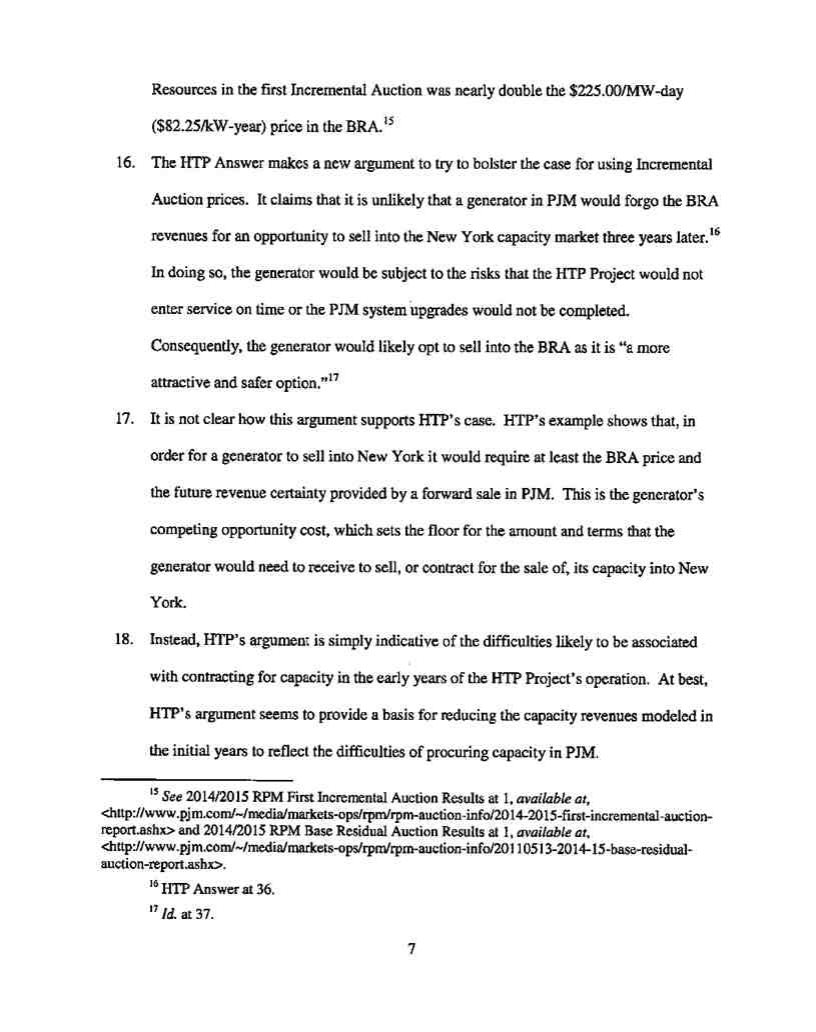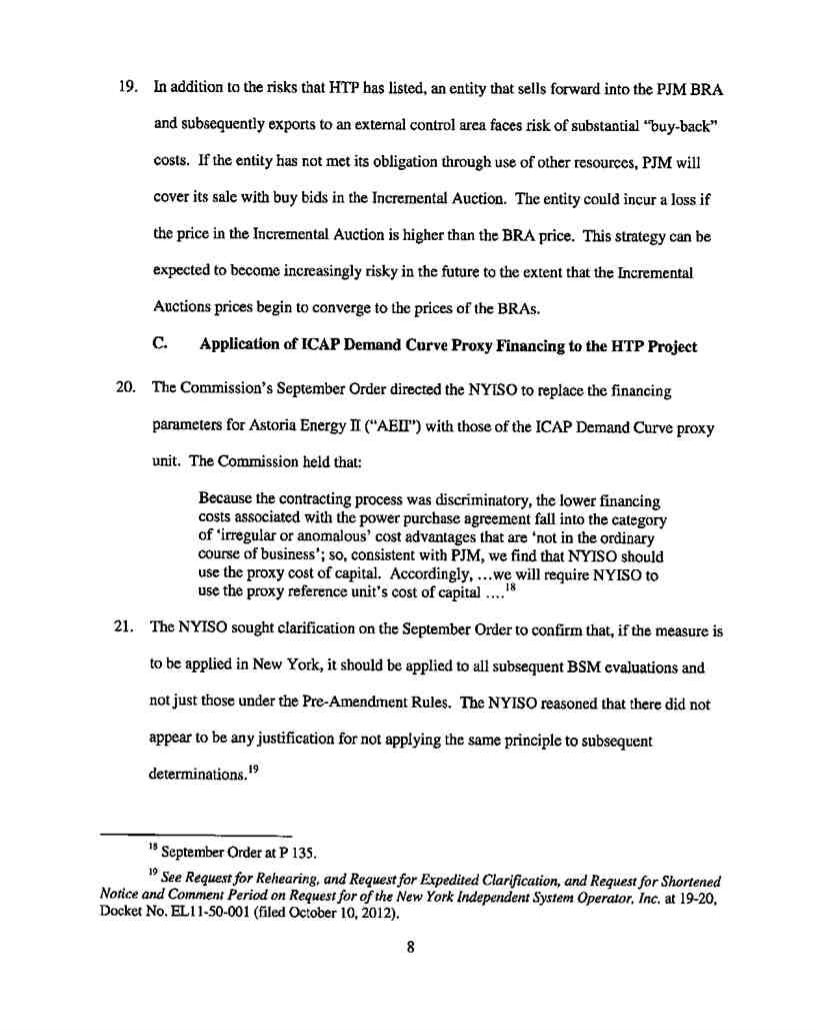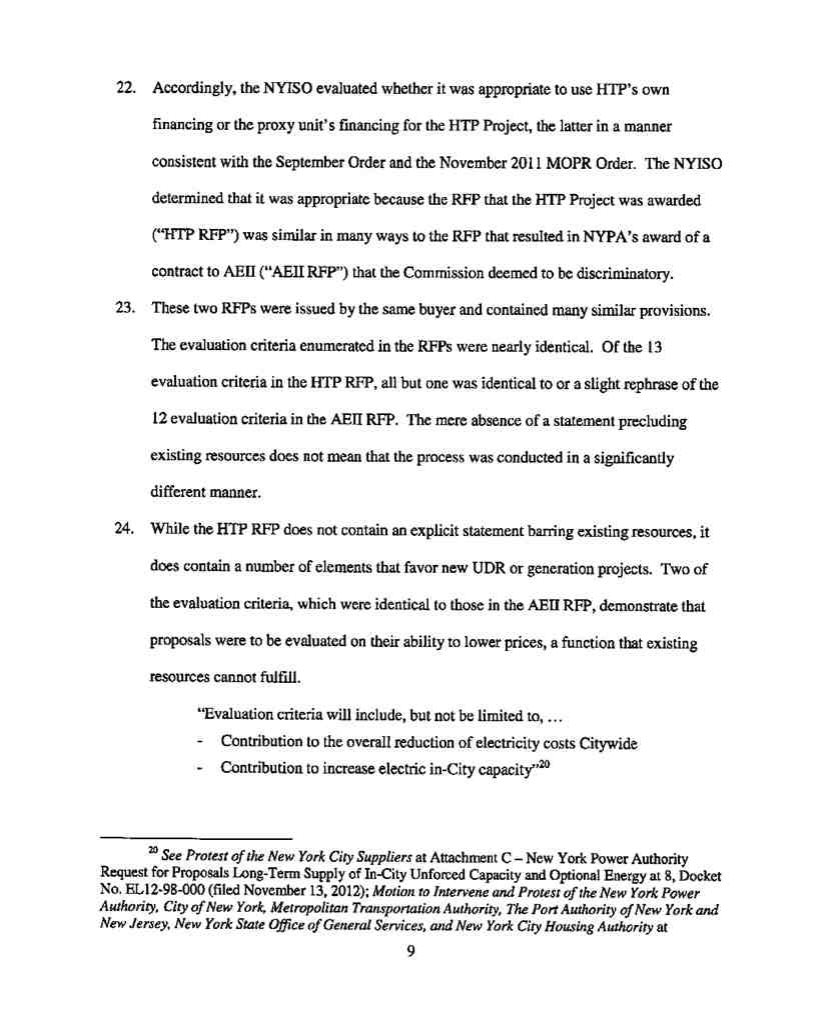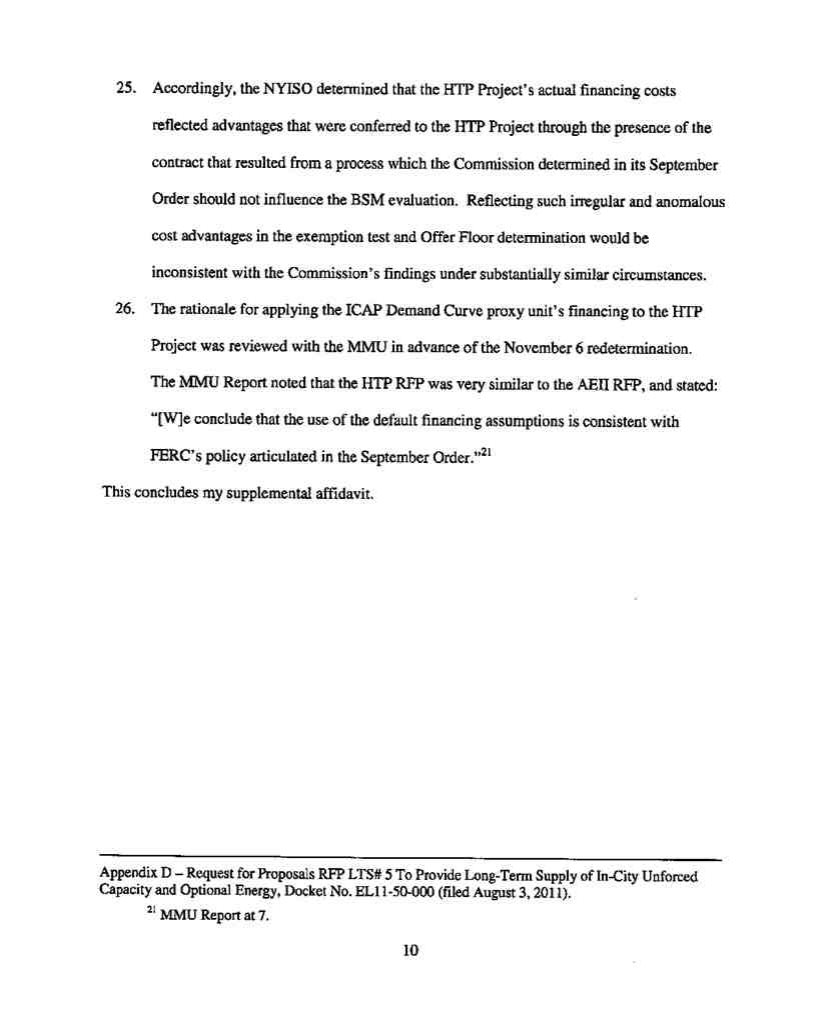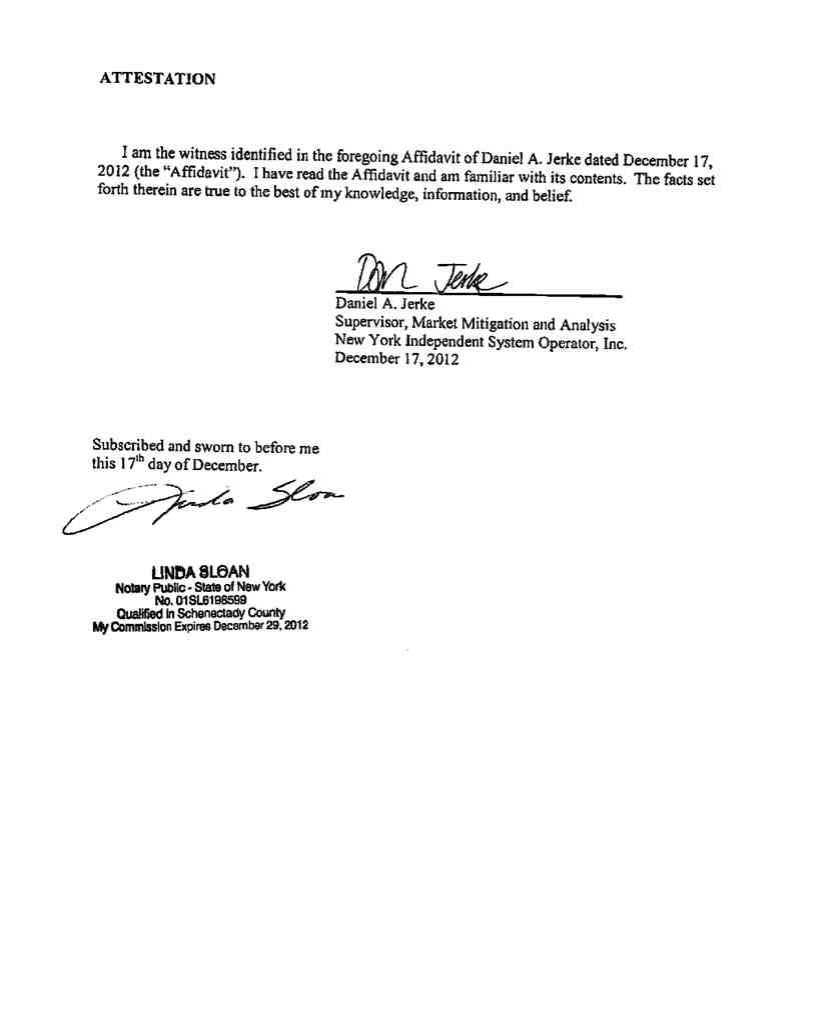UNITED STATES OF AMERICA
BEFORE THE
FEDERAL ENERGY REGULATORY COMMISSION
Hudson Transmission Partners, LLC
v.
New York Independent System Operator, Inc.
)
)
)Docket No. EL12-98-000
)
)
REQUEST FOR LEAVE TO ANSWER AND ANSWER OF
THE NEW YORK INDEPENDENT SYSTEM OPERATOR, INC.
In accordance with Rule 213 of the Commission’s Rules of Practice and Procedure,1 the
NYISO respectfully submits this answer to the Motion for Leave to Answer and Answer of
Hudson Transmission Partners, LLC (“HTP Answer”) in this proceeding.2 For the reasons set
forth herein and in the NYISO’s November 13 Answer (“NYISO Answer”), the Commission
should reject the arguments originally made in Hudson Transmission Partners, LLC’s
(“Complainant’s”) original August 3, 2012 complaint (“August Complaint”) and the new and
amended arguments set forth in the HTP Answer. Neither the August Complaint nor the HTP
Answer satisfy Complainant’s burden of proof under the Federal Power Act. Complainant still
has not shown that the NYISO violated or “improperly implemented”3 its tariff or otherwise
acted unjustly or unreasonably, or in an unduly discriminatory manner. The NYISO correctly
determined that Complainant’s merchant transmission project (“HTP Project”) would be subject
1 18 C.F.R. § 385.213 (2012).
2 As discussed in Section I, because the HTP Answer raises new issues and substantially modifies
Complainant’s prior arguments, it should be treated as an amendment to the HTP Complaint.
Accordingly, the NYISO is entitled to answer it as of right. To the extent that the Commission does not
treat the HTP Answer as an amended complaint, the NYISO respectfully requests leave to answer, as
discussed below.
3 August Complaint at 1.
to Offer Floor4 mitigation upon entry. The NYISO therefore continues to request that the August
Complaint along with the new arguments in the HTP Answer be denied in their entirety.
This answer does not address the November 28th Motion for Leave to Answer and
Limited Answer of TC Ravenswood, LLC to Protest and Answer Regarding Complaint of Hudson
Transmission Partners, LLC (“TCR Limited Answer”). The NYISO disagrees with the
arguments set forth in that pleading but has already addressed them in the NYISO Answer and in
other dockets.5
I.REQUEST FOR LEAVE TO ANSWER
The HTP Answer does not simply respond to the NYISO Answer. Instead, it introduces
new claims that were not included in the August Complaint and revises arguments that were
included. Complainant’s new claims include its objection to the cost of capital used in the
NYISO’s Offer Floor determination, its assertion that certain mothballed units should have been
excluded from the NYISO’s energy revenue forecasts, and its attempted use of the “analysis
reference date” rulings from the Commission’s September 10, 2012 order in Docket
No. EL11-50-000 (“September Order”).6 The HTP Answer also changes its original argument
4 Terms with initial capitalization that are not otherwise defined herein have the meaning set forth in the NYISO’s Market Administration and Control Area Services Tariff (Services Tariff), as modified by Commission’s June 22, 2012 Order (Astoria Generating Company, L.P., et al. v. New York Independent System Operator, Inc., 139 FERC ¶ 61,244 (2012)), and accordingly as described in the NYISO’s
August 6, 2012 compliance filing in Docket No. ER12-2414-001. If not defined therein, the term shall have the meaning set forth in the Open Access Transmission Tariff (“OATT”).
5 See, e.g., Motion to Intervene, Comments, Request for Limited Tariff Waivers, and Alternative Protest of the New York Independent System Operator, Inc., Docket No. ER12-1418-000 at 12-19
(April 12, 2012). To the extent that the Commission considers the issues raised by the TCR Limited Answer in this proceeding, the NYISO respectfully requests that its arguments in Docket
No. ER12-1418-000 be deemed to be incorporated by reference into this filing.
6 Astoria Generating Co., et al. v. New York Independent System Operator, Inc., 140 FERC ¶ 61,189 at PP 134-137 (2012) (“September Order”).
2
for “reliability benefits compensation.”7 The HTP Answer is therefore tantamount to an
amendment to the HTP Complaint that the NYISO would be permitted to answer as a matter of
right.8
To the extent the Commission concludes that the HTP Answer should not be treated as an amended complaint, it should exercise its discretion to accept this answer. Regardless of
whether the HTP Answer is deemed to be an amended complaint, it raises new issues and offers revised arguments that the NYISO has not had an opportunity to address before. Simple fairness dictates that the NYISO be permitted to respond.
In addition, the Commission has previously accepted answers when they help to clarify complex issues or aid the Commission in its decision-making process.9 This answer should be accepted because it corrects the HTP Answer’s factual errors and mischaracterizations, as well as the misinterpretations of the Services Tariff. Accepting this answer will therefore clarify the record and facilitate the Commission’s review in this case.
The NYISO has limited the scope of this answer to responding to Complainant’s new and revised arguments, and to making the types of record corrections noted above. This approach should not be construed as agreement with, or acceptance of, other assertions in the HTP Answer that the NYISO has chosen not to address.
7 The HTP Answer also withdraws the August Complaint’s arguments regarding the NYISO’s exclusion of certain categories of “sunk costs” from the Unit Net CONE analysis for the HTP Project. HTP Answer at 4, n.15.
8 18 C.F.R. §385.215 (2012).
9 See e.g., New York Independent System Operator Inc., 133 FERC ¶ 61,178 at P 11 (2011)
(allowing answers to answers and protests “because they have provided information that have assisted [the Commission] in [its] decision-making process”); Morgan Stanley Capital Group, Inc. v. New York Independent System Operator, Inc., 93 FERC ¶ 61,017 at 61,036 (2000) (accepting an answer that was “helpful in the development of the record…”).
3
II.ANSWER
A.HTP has Failed to Show that the NYISO’s “Scaling Factor” Adjustment Was
Inappropriate or Unreasonable
The NYISO Answer refuted the August Complaint’s allegations that applying a “scaling
factor” adjustment in the NYISO’s determination of the HTP Project’s net energy revenues was
unlawful, discriminatory, or unreasonable. The NYISO explained that this adjustment was
firmly rooted in the Services Tariff’s requirement that the NYISO’s Unit Net CONE examination
under its buyer-side mitigation rules (“BSM Rules”)10 reasonably estimate net energy revenues.
If such an adjustment were not made then the energy revenues for transmission projects used in
the BSM determination would be unrealistically overstated because the NYISO implicitly would
be assuming that such projects could perfectly arbitrage inter-regional price differences. An
assumption of perfect arbitrage of NYISO and PJM Interconnection (“PJM”) prices would thus
not have resulted in a “reasonable estimate” of energy revenues. Applying the scaling factor to
the estimate of the HTP Project’s estimate of net energy revenues was also not unduly
discriminatory because it reflected the significant differences between the manner in which net
energy revenues are available using the HTP Project compared to generators.
The HTP Answer concedes that perfect arbitrage of inter-regional prices across the PJM-
NYISO interface is currently not possible.11 It also admits that the Services Tariff requires the
NYISO to project “likely” energy revenues. Nevertheless, it asserts that the NYISO should not
be allowed to use a scaling factor to account for the impossibility of perfect arbitrage in its
energy revenue projections. Essentially, Complainant recognizes that the NYISO had to do
10 The BSM Rules are set forth at section 23.4.5.7 of Attachment H to the NYISO’s Services
Tariff.
11 HTP Answer at 31 (stating that Complainant “does not contend that it would be able to
perfectly arbitrage day-ahead price differences between the PJM and the NYISO markets... Hudson
Transmission also recognizes that perfect arbitrage is not possible in the real-time markets ”).
4
something to satisfy the Services Tariff’s “reasonable estimate” requirement; however, it then argues that such an adjustment should not have been made. Its objection is an illogical and unsupported challenge to the legality of, or the necessity for, the NYISO’s actions.
Complainant next argues that the scaling factor adjustment was flawed because it
“effectively assumes that Hudson Transmission must earn all of its revenues from the day-ahead
market.”12 In fact, the NYISO’s analysis considered revenues from both the day-ahead and real-
time markets. As explained in the NYISO Answer, and reiterated in the attached Supplemental
Affidavit of Daniel A. Jerke (“Supplemental Affidavit”), the NYISO used a scaling factor that
was equal to the ratio of (a) historic net energy revenues from the day-ahead and real-time
markets to (b) theoretical net energy revenues from the day-ahead market over the same historic
time period.13 The NYISO did not assume that the HTP Project’s customers (i.e., Market
Participants’ using it to sell energy) would not participate in the real-time market. To the
contrary, as described in the Supplemental Affidavit, the NYISO calculated the scaling factor
adjustment using historic day-ahead and real-time revenues.14 Combined historic day-ahead and
real-time revenues were considerably less than the theoretical maximum day-ahead net revenues,
but the real-time revenues included in the NYISO’s calculation were far greater than zero or the
de minimis amounts claimed by the Complainant.15
Complainant’s erroneous assumptions appear to have resulted from its not being aware of
changes in the NYISO’s approach that developed after the NYISO provided Complainant with
the information included in Attachment 4 to the HTP Answer. Attachment 4 correctly indicates
12 HTP Answer at 30.
13 See NYISO Answer at 17.
14 See Supplemental Affidavit at PP 7-11.
15 Id.
5
that in August 2011 the NYISO intended to account for just ten percent of theoretically
achievable real-time net energy revenues in determining a “reasonable estimate” of HTP Project
revenues. After further review, and after considering input from the independent Market
Monitoring Unit (“MMU”), and prior to December 2011 Offer Floor determination, the NYISO
revised its approach and adopted the calculation method described above.16 The NYISO also
used this approach in its analysis under the BSM Rules for the HTP Project’s November 2012 re-
determination.
The HTP Answer looks to the MMU Report to support its erroneous claim that the
NYISO wrongly included mothballed units in its energy revenue projections.17 When the
NYISO calculates net energy revenues for an Examined Facility, the level of excess modeled is
largely based on the amount of capacity modeled in the ICAP forecast. Under the Services
Tariff, a resource should only be removed from the ICAP forecast used in the BSM mitigation
determination if it has filed a notice of retirement with the New York State Public Service
Commission.18 As of December 2011, there were no resources in New York City that had
submitted a “retirement” notice since the April 2011 publication of the 2011 Load and Capacity
Data Report (i.e., the “Gold Book”). It would therefore have been inappropriate to remove any
MW from the ICAP forecast used in the December 2011 determination. There was likewise no
basis for any adjustment to be made in the November 2012 determination.
16 Although this adjustment in the NYISO’s approach was not discussed with Complainant, it was foreseeable that it would be a favorable change from Complainant’s perspective.
17 HTP Answer at 35; citing MMU Report at 11.
18 See Services Tariff at § 23.4.5.7.3.2.
6
B.HTP has Not Shown that it Would Be Reasonable for the NYISO to Use
Capacity Prices from PJM’s Incremental Auctions in its Analyses or that it Was Unreasonable for it to Have Used PJM’s Base Residual Auction
(“BRA”) Prices
The HTP Answer repeats the August Complaint’s claims that the NYISO should not have
used PJM BRA prices to estimate the price of PJM capacity and should have instead looked to
prices in PJM’s incremental auctions.19 The NYISO Answer refuted this argument in detail. It
demonstrated that there were many important similarities between the NYISO’s ICAP Spot
Market Auctions and the PJM BRAs, and many material distinctions between the ICAP Spot
Market Auctions and PJM’s incremental auctions. These considerations far outweighed the
superficial timing similarities between the NYISO auctions and PJM’s incremental auctions.
The HTP Answer offers virtually nothing to contest the points made in the NYISO
Answer. Instead, the HTP Answer tries a new argument. It claims that it is unlikely that PJM
generators would opt out of the BRA in order to sell their capacity into New York three years
later. The Supplemental Affidavit explains that this theory does not appear to support
Complainant’s argument at all since it mostly has to do with contracting uncertainties that UDR
rightsholders may experience during the early years of the HTP Project’s operations.20 If
anything, the argument suggests that the projected revenues for the HTP Project should be
adjusted to a level lower than what the NYISO actually used in its analysis.21 Complainant’s
new argument also does not alter the reality that the differences between the incremental auctions
and the NYISO’s auctions that were described in the NYISO Answer are far greater than the
comparatively minor ones between the BRAs and NYISO spot auctions.
19 HTP Answer at 36-37; August Complaint at 48-49.
20 See Supplemental Affidavit at PP 13-19.
21 Id. at P 18.
7
C.HTP has Failed to Show that the NYISO Was Wrong to Examine the HTP
Project Concurrent with Class Year 2010 Examined Facilities
The NYISO Answer explained that although the HTP Project was in Class Year 2008 that the BSM Rules and the February 2011 Order22 clearly required that it be analyzed concurrent
with other Examined Facilities that shared the same Starting Capability Period.23 This treatment was driven by the Commission’s acceptance of Complainant’s express request that the entry date for the HTP Project be determined using the “Reasonably Anticipated Entry Date Rule,”24
instead of the “Three Year Rule.”25
Complainant’s principal response to the NYISO Answer is a brand new claim that
Section 23.4.5.7.3 of the Services Tariff does not permit the NYISO to treat the HTP Project as a
“Category III” Examined Facility.26 In reality, the HTP Project unquestionably is, and was
always intended to be,27 a “Category III” facility. The HTP Project has all of the substantive
characteristics of a Category III(a)(i) project. At the time that the NYISO filed the BSM Rules,
it was “in the ISO Interconnection Queue, in a Class Year prior to 2009/10,” had not yet
“commenced commercial operations or been canceled” and the NYISO had not previously made
“an exemption or Unit Net CONE determination” for it. Significantly, the HTP Project was the
only project to have these attributes and thus was the only project covered by the Category
III(a)(i) definition. Neither the NYISO’s filing proposing the BSM Rules, which introduced the
22 New York Independent System Operator, Inc., 134 FERC ¶ 61,083 (2011).
23 See NYISO Answer at 10-14.
24 Under the “Reasonably Anticipated Entry Date Rule” the mitigation exemption analysis used a
starting date based on when an ICAP Supplier was reasonably anticipated to first offer to supply UCAP.
25 Under the “Three-Year Rule” the mitigation exemption analysis uses a start date based on the
Summer Capability Period that begins three years from the start of the proposed facility’s Class Year.
26 See HTP Answer at 12-19.
27 Complainant is thus wrong to suggest that the NYISO meant to exclude the HTP Project from the Category III definition. See HTP Answer at n. 40.
8
Category III definition, nor its communications to its stakeholders,28 articulated any reason why the HTP Project would be outside the scope of Category III. Other parties in this proceeding
have indicated that they understood the intended scope of the Category III definition to include the HTP Project.29
The Services Tariff definition of Category III facilities does not expressly reference
“UDR projects” as the Category I and II definitions do. That does not mean, however, that the Category III definition is inapplicable to the HTP Project. The Services Tariff definition of
“Generator” is very broad. It encompasses any “facility capable of supplying Energy, Capacity and/or Ancillary Services that is accessible to the NYCA.” By contrast, “UDR project” is not a defined term in the Services Tariff.30 The absence of a reference to “UDR projects” from the Category III definition therefore should not be used as the basis for a formal presumption that the HTP Project was meant to be excluded from that definition.
The UDR rules permit Unforced Capacity outside of a Locality, which in the case of the
HTP Project is capacity located in an External Control Area, to be treated the same as Generators
28 Moreover, NYISO presentations to its stakeholder during the development of the BSM Rules clearly indicated that all three Categories of “Examined Facilities” encompassed “entities,” i.e., both generators and merchant transmission projects. See, e.g., the NYISO August 25, 2010 presentation to the Management Committee at p. 5, available at
<http://www.nyiso.com/public/webdocs/markets_operations/committees/mc/meeting_materials/2010-08-
25/agenda_07_pres_Exemption_Determination_and_Duration_of_Offer_Floor.pdf>.
29 See Protest of the New York City Suppliers at 15-19, Docket No. EL12-98-000 (November 13,
2102).
30 The Services Tariff defines Unforced Capacity Deliverability Rights, but does not define the
term “UDR project.” See Services Tariff §2.21 at definition of Unforced Capacity Deliverability Rights.
That definition describes that the UDR must be “combined with Unforced Capacity which is located in an
External Control Area or non-constrained NYCA region” is Locational (in this case, Zone J) Installed
Capacity. Thus it would not be appropriate to solely use the term “UDR” in the BSM Rules. The UDR
when coupled with capacity from outside the relevant NYCA Locality is referred to as a “UDR project”
for purposes of the BSM Rules.
9
electrically located within a Locality.31 It is therefore entirely natural to read the Category III
definition to encompass the HTP Project. The Commission has also previously held that the
NYISO buyer-side mitigation measures apply to merchant transmission facilities, including
specifically the HTP Project. It has been clearly understood that controllable transmission and
generation capacity “should be subject to the same mitigation” since the issuance of the
Commission’s March 2008 order.32 This has been the case even though the Pre-Amendment
Rules33 did not expressly reference controllable transmission lines. In addition to it being the
NYISO’s intent to provide an explicit basis to examine the HTP Project which had not been
examined under the Pre-Amendment Rules, it was reasonable to read the Category III definition
to include the HTP Project. The absence of an express reference to “UDR projects” from the
Category III definition therefore should not be used as the basis for drawing a formalistic
inference that the HTP Project was meant to be excluded from that definition.34
Complainant cannot legitimately claim a reliance interest in its newly-asserted
interpretation of the Category III definition. Any claim of detrimental reliance by HTP belies its
position in the HTP Answer and in earlier pleadings that the HTP Project’s “go forward” date
was nearly a year before the NYISO filed the BSM Rules.35 Complainant does claim that it
would have challenged or sought clarification of Section 23.4.5.7.3 if it had thought that
31 See Services Tariff Section 2.21.
32 New York Independent System Operator, Inc., 122 FERC ¶ 61,211 at P 121 (2008).
33 The “Pre-Amendment Rules” were the buyer-side capacity market power mitigation rules that existed in Attachment H to the NYISO Services Tariff prior to the November 27, 2010 effective date of the BSM Rules.
34 See also Linden VFT, LLC v. New York Independent System Operator, Inc., 141 FERC
¶ 61,008 at PP 29-30 (2012), where the Commission determined that it was appropriate to interpret the term “generators” to include controllable lines.
35 See HTP Answer at 23-24; August Complaint at 62.
10
Category III might have been read to include the HTP Project.36 Whether this claim is true, or
merely opportunistic, is of little practical consequence since Complainant’s interpretation is now
squarely before the Commission in this proceeding. If the Commission rejects Complainant’s
position in this proceeding, then Complainant would have no basis for raising due process
objections.
Adopting Complainant’s interpretation would have illogical and perverse unintended
consequences. It would read the HTP Project out of the portion of the “Examined Facility”
definition that was specifically crafted to include it (i.e., Category III(a)(i)). It would therefore
completely remove the HTP Project from the definition of “Examined Facilities” because it
cannot properly be included in Category “I” or “II”. Such a result would contradict both the
intent of the BSM Rules and the canon of construction that dictates that the Services Tariff must
not be read in a manner that would render the Category III(a)(i) definition superfluous or
inoperative.
Complainant does not claim that the HTP Project comes within the ambit of Category II
but argues that it should have been treated as a “Category I” facility.37 Complainant’s reading of
the Category I definition is not tenable. The Services Tariff defines a Category I facility as one
that:
requested CRIS, or that requested an evaluation of the transfer of CRIS rights from another location, in the Class Year Facilities Study commencing in the calendar year in which the Class Year Facilities Study determination is being made (the Capability Periods of expected entry as further described below in this Section, the “Mitigation Study Period”).38
36 See id. at n.40.
37 See id. at 12-19.
38 Services Tariff at §23.4.5.7.3(I).
11
When the NYISO first proposed the BSM Rules it requested expedited Commission
action so that its tariff revisions could take effect by November 2010.39 It explained that
Commission action was needed by then because Class Year 2009 and Class Year 2010 projects
were expected to receive and consider their Project Cost Allocations in that timeframe.40 The
projects’ decision point in the Project Cost Allocation process would mark the “commencing” of
the “Class Year Facilities Study in the “calendar year in which the Class Year Facilities Study
determination” was being made, and under the then-proposed and now-accepted BSM Rules was
to coincide with the NYISO’s issuance to the projects of the exemption and Offer Floor
determinations. Thus, for the first examinations under the new BSM Rules, it is Class Year 2009
and Class Year 2010 projects that belonged in Category I.41 The HTP Project, as a member of
Class Year 2008, did not. The HTP Answer itself implicitly acknowledges this distinction by
observing that Astoria Energy II (“AEII”) and the Bayonne Energy Center (“BEC”) could not
possibly satisfy the requirements of Category II or III because “neither . . . is in a Class Year
prior to 2009/2010.... ” 42 It follows that the HTP Project, as the only project in a Class Year
prior to 2009 that had not yet entered the market,43 which therefore meant that a determination under the BSM Rules had to be made, could only be a Category III facility because it did not fit within Category I or Category II.
39Proposed Enhancements to In-City Buyer-Side Capacity Mitigation Measures, Request for
Expedited Commission Action, and Contingent Request for Waiver of Prior Notice Requirement, Docket No. ER10-3043-000 (filed September 27, 2010) (“BSM Rules Filing”).
40 See BSM Rules Filing at 17-19.
41 See New York Independent System Operator, Inc., 139 FERC ¶61,244 at P 134 (holding that the
Order’s directives for retests under and changes directed to the BSM Rules were not intended to affect
determinations made for projects prior to the November 27, 2010 effective date of the BSM Rules).
42 HTP Answer at 13-14.
43 Under the Pre-Amendment rules, projects that entered the market were either grandfathered
pursuant to Section 23.4.5.7.6, or were examined for an exemption or Offer Floor determination.
12
Moreover, if Complainant’s tariff interpretation were to prevail, and the NYISO were required to analyze the HTP Project prior to and independent of its analysis of Class Year 2009 and Class Year 2010 projects, substantial market uncertainty would be created. Such a drastic change would necessarily impact the exemption re-determinations that the NYISO recently
completed for AEII and BEC.
If the Commission concludes that the current version of the Category III(a)(i) definition does not encompass the HTP Project, it should waive that limitation in order to preserve the
intent of the provision and to avoid the consequences described above.44 Alternatively, if the Commission believes that the definition is insufficiently clear, it could direct the NYISO to make a compliance filing to “correct” the definition to expressly include “UDR projects” or to make any other “corrections” that it deems necessary.45
The HTP Answer’s remaining tariff arguments are all devoid of merit. They fail because they are dependent on Complainant’s flawed interpretation of the Category III definition or
because they are contradicted by the February 2011 Order’s express directive that the
44 To the extent that a waiver of the “Category III” definition is needed, granting one would be consistent with the Commission’s four-prong waiver test. See, e.g., PJM Interconnection, LLC, 137
FERC ¶61,184 at P 13 (2011); New York Independent System Operator, Inc., 136 FERC ¶ 61,193 at P 67 (2011). The NYISO has acted in good faith (and nothing in the record suggests otherwise), the waiver would be of limited scope (since the HTP Project is the only “Category III” facility); granting the waiver would remedy a “concrete problem,” and there would be no undesirable consequences, including harm to third parties (since no party, including Complainant, could have a legitimate interest in the BSM Rules being applied in a manner contrary to their intended design).
45 The Commission has previously accepted “errata” filings that corrected typographical errors
and other clerical drafting issues months or years after the underlying tariff language was accepted. See,
e.g., New York Independent System Operator, Inc., Letter Order Docket No. ER12-416-000
(December 27, 2011) (accepting an errata to a filing over a year after the provisions had been filed,
accepted and made effective); New York Independent System Operator, Inc., Letter Order, Docket Nos.
ER04-230-037 and ER04-230-038 (Sept. 5, 2008) (accepting revised sheets to include erroneously
omitted language and correct the table of contents several months after the Commission’s acceptance of
the filing). Thus, the NYISO could propose any correction that the Commission deems necessary, or the
Commission could require such a correction on its own initiative, without engaging in impermissible
“retroactive” tariff revisions.
13
Reasonably Anticipated Entry Date Rule apply to the HTP Project. As the NYISO Answer
explained, the Commission’s order required the NYISO to use a May 2013 entry date for the HTP Project. Using that entry date placed the HTP Project in the same Mitigation Study Period as the Class Year 2010 projects. To the extent that the Commission might conclude that any tariff provisions are arguably inconsistent with this outcome, it must read them as consistent with the February 2011 Order. Otherwise the February 2011 Order would have no meaning. As the NYISO Answer noted, it is simply not plausible for Complainant to try now to escape from the implications of a Commission ruling that it specifically sought.46
Finally, the HTP Answer repeats Complainant’s earlier mischaracterization of a
September 2010 NYISO data request by claiming that it somehow shows that the NYISO
initially interpreted the Services Tariff as “requiring it to first render a MET [mitigation
exemption test] determination for the Class Year 2008 project before it could start the
Attachment S costs allocation and Attachment H MET determination for projects in Class Years
2009 and 2010.”47 The NYISO Answer explained that this claim is inaccurate.48 The HTP
Answer simply ignores the NYISO’s explanation and continues to make factually inaccurate
assertions.
D. The HTP Answer’s Claims Regarding the Proper “Analysis Reference Date”
for the HTP Project Are Based on Inapplicable Precedent
The HTP Answer invokes the September Order to try to bolster its argument that the
NYISO should have conducted the exemption determination for the HTP Project using
information available as of its “go forward” date, or, as newly crafted by the HTP Answer, its
46 See NYISO Answer at 11-12; see also, September Order at P 3 (establishing that the Pre-
Amendment Rules were applicable to exemption determinations made prior to November 27, 2010 and that the BSM Rules applied to all determinations made from that date onward).
47 HTP Answer at 26-27.
48 See NYISO Answer at 10-14.
14
“analysis reference date.”49 Complainant is attempting to apply a ruling that was confined to a
single project (i.e., AEII) that was evaluated under the Pre-Amendment Rules, and which is
differently situated than the HTP Project. The HTP Project exemption determination is being
conducted under the BSM Rules, which, unlike the less- detailed Pre-Amendment Rules, make it
absolutely clear that exemption analyses must be based upon the applicable Mitigation Study
Period for each Examined Facility. Complainant is wrong to suggest that this clear tariff
language should be overridden in order to achieve consistency with an inapplicable precedent.
Complainant is also wrong to contend that it was entitled to an earlier determination
under the Pre-Amendment Rules.50 Contrary to the HTP Answer’s claims, the NYISO correctly
made its initial exemption determination for the HTP Project in December 2011 and correctly
used data and other inputs available at that time. This timing of the determination was not the
product of a discretionary “delay” by the NYISO.51 Complainant did not request an exemption
determination under the Pre-Amendment Rules and did not provide all of the information
required to calculate its Unit Net CONE at least 60 days prior to the commencement of the Initial
Decision Period, as specified under the Pre-Amendment Rules.52 Adding specificity to the
timing of the NYISO’s exemption determinations was a principal reason why the NYISO
introduced the BSM Rules in the first place.53 Complainant itself has previously made multiple
49 HTP Answers at 5; citing September Order at P 79.
50 See HTP Answer at 20-22, n.14.
51 Id. at 25-26.
52 See Pre-Amendment Rules at § 4.5 (g)(ii).
53 See New York Independent System Operator, Inc., 133 FERC ¶61,178 at P 71 (2010) (finding “it reasonable that under the proposed revisions, NYISO will make exemption determinations regardless of whether or not an exemption test is requested”); see also BSM Rules Filing at 9 (stating that the
existing language did “not expressly address the NYISO’s responsibilities if it does not receive a request for an exemption …”).
15
admissions that the HTP Project had to be analyzed under the BSM Rules.54 There is thus no
merit to Complainant’s assertion that the NYISO should have looked to an earlier “analysis
reference date,” and thus to earlier data and other inputs, in its exemption determinations for the
HTP Project.
E.The NYISO Reasonably Concluded that the September Order Required it to
Use a Proxy Cost of Capital in the HTP Project’s Exemption
Redetermination Analysis
The Commission’s September Order held that the NYISO must use the ICAP Demand
Curve proxy unit’s cost of capital in its exemption analysis for AEII. According to the
September Order, AEII’s financing costs were lower because it was selected through a
“discriminatory” RFP process that gave it an “irregular and anomalous” advantage.55 On
rehearing, the NYISO challenged the holding as applied to AEII and sought clarification
regarding its applicability to other exemption analyses. The Commission has not yet responded
to this request.56
54 See, e.g., Motion to Withdraw of the Hudson Transmission Partners, LLC at 2, Docket No.
EL11-42-000 (filed July 29, 2011) (acknowledging that the HTP Project was subject to the BSM Rules,
that it was the sole member of Class Year 2008, and that Class Year 2008 was the first Class Year subject to the BSM Rules); Comments of the Hudson Transmission Partners, LLC at 7, 11-12, Docket No. EL11-
42-000 (filed July 7, 2011) (“As a new controllable merchant transmission line into NYISO’s Zone J
starting with Class Year 2008 that has Capacity Resource Interconnection Service, the Hudson
Transmission project is subject to the proposed MET process being performed by the NYISO” and that
“Class Year 2008 is also subject to the NYISO’s proposed new MET methodology. …HTP is the only
new entrant in Zone J in Class Year 2008. HTP faces exactly the same stakes associated with the
NYISO’s ‘potentially binding mitigation determinations based on the current rules for the first time in the pending Class Year interconnection process’”).
55 September Order at P 135.
56 See Request for Rehearing, and Request for Expedited Clarification and Request for Shortened
Notice and Comment Period on Request for Clarification, of the New York Independent System Operator,
Inc., Docket No. EL11-50-001 at 19-20 (October 10, 2012) (seeking confirmation that to the extent that
other power purchase agreements have been, or may in the future be, awarded to projects under RFP
processes that are “limited to new resources” the NYISO would use an appropriate proxy cost of capital
in its analysis).
16
The NYISO Answer stated that the NYISO interpreted the Commission’s September
Order as requiring it to apply the financing assumptions for the proxy unit used to establish the
New York City ICAP Demand Curve to the HTP Project. 57 This interpretation was based on the
NYISO’s post-September Order review and comparison of the RFPs that resulted in contracts
being awarded to AEII (“AEII RFP”) and the HTP Project (“HTP RFP”), respectively. After the
Commission’s issuance of the September Order, and in relation to the re-test of the HTP Project
required by the June Order, the NYISO obtained additional information from Complainant
concerning the HTP Project’s cost of capital, and the impact of the contract with NYPA on its
financing.58 The NYISO concluded that there were differences between the two RFPs but that
the HTP RFP contained evaluation criteria similar to that which the September Order determined
favored new projects over existing facilities. A number of the HTP RFP’s features that appear to
be preferential are identified in the Protest of the New York City Suppliers.59 The MMU
concurred that “the use of the default financing assumptions is consistent with FERC’s policy
articulated in the September Order.”60 Complainant has argued that the HTP RFP was not
preferential. There is nothing further for the NYISO to add to the factual record on this issue.
The NYISO would emphasize, however, that Complainant is wrong to suggest that the NYISO has adopted a “presumption” that “any RFP conducted by NYPA, regardless of its actual terms must be unduly discriminatory because NYPA conducted it.”61 No such presumption has been adopted. The NYISO has administered and will continue to administer the BSM Rules
57 See NYISO Answer at 3.
58 See Supplemental Affidavit at PP 20-26.
59 See Protest of the New York City Suppliers at n.9, Docket No. EL12-98-000 (filed November 13, 2012).
60 See MMU Report at 6-7.
61 HTP Answer at 41 (original formatting deleted).
17
impartially. It has no bias against (or in favor of) NYPA or any other Market Participant. The
NYISO has challenged the application of the “irregular and anomalous financial advantages”
rule to AEII. Nevertheless, the NYISO has attempted to comply with the September Order in
good faith and believes that it is most reasonably read as requiring the use of proxy unit
financing assumptions in its BSM Rule analysis of the HTP Project.
Finally, the NYISO disagrees that the Commission’s 2011 ruling in Hudson Transmission is relevant to, let alone dispositive, in this proceeding. In that case, the Commission found that the “use of an open, competitive, and government-entity led RFP process to initially allocate
75 percent of the transmission capacity” ensured that “Hudson Transmission has not acted in an
unduly discriminatory manner with regard to the allocation of capacity to NYPA... ”62 This is
irrelevant to the question of whether NYPA’s selection of the HTP Project conferred “irregular
and anomalous” financing advantages for purposes of the application of the September Order’s
ruling.
F. The HTP Answer Appears to Moot the August Complaint’s Claim for Non-
Market Based “Reliability Benefits” Compensation, But to the Extent that the Commission Considers that Claim It Should Be Rejected
The August Complaint advanced the radical theory that merchant transmission projects
that were subject to market power mitigation should receive supplemental non-market-based
compensation to the extent that they might provide “reliability benefits.”63 The NYISO Answer
demonstrated in detail that Complainant’s request was inappropriate and unlawful. Among other
things, Complainant’s theory was procedurally defective, inconsistent with Commission policy
and precedent, incompatible with the NYISO’s market design, and impracticable to implement.
62 Hudson Transmission Partners, LLC, 135 FERC ¶61,104 at P 28 (2011).
63 August Complaint at 51-61.
18
It also threatened to defeat the purpose of the BSM Rules by seriously undermining their ability to deter uneconomic entry.64
The HTP Answer tries a different approach. It asks the Commission to find that the
Services Tariff does not require a UDR holder to return UDRs to the NYISO if they are not used
to sell or import capacity to the NYISO.65 Complainant suggests that if this interpretation were
confirmed then there would be no need for the Commission to reach the question of whether a
non-market based compensation mechanism to support uneconomic entrants is needed.
Complainant’s revised argument appears to moot the August Complaint’s claim for
“reliability benefits” compensation. The Commission has required that the UDR rights
associated with the HTP Project be transferred to NYPA, “anchor” customers, and other
rightsholders selected through an open season process.66 The NYISO’s tariffs and manuals are fully consistent with that Commission directive to HTP. The tariffs and manuals do not compel the UDR rightsholders that are ICAP Suppliers to offer capacity (i.e., use the rights) except for certain instances where they are Pivotal Suppliers or are subject to other anti-market
manipulation related requirements.
The HTP Answer’s reference to the transfer of UDR rights to third parties is not wholly
clear. UDRs are granted to projects. Consistent with the Commission’s orders requiring that the
rights to use UDRs associated with the HTP Project be transferred to third party rightsholders,
the NYISO’s tariffs and manuals accommodate transfers to rightsholders. There is no
prohibition in the NYISO’s tariffs and manuals on an assignment of such rights to a third party
(provided the third party agrees to adhere to rules). The tariffs and manuals also do not force
64 NYISO Answer at 28-31.
65 HTP Answer at 42.
66 Hudson Transmission Partners, LLC, 135 FERC ¶ 61,104 at P 29 (2011).
19
UDR rightsholders to take any action. They are free to voluntarily choose each auction to use or not use their UDR rights to support offers of capacity,67 or notify the NYISO that they elect to return them for the next following Capability Year.
Because the NYISO’s tariffs and manuals do not require UDR rightsholders to return
their rights if they are not used, it appears, given the way Complainant has framed its revised
argument, that there is no need for the Commission to address the “reliability benefits” question. If, however, the Commission chooses to take up the issue it should reject Complainant’s theory for the reasons specified in the NYISO Answer.
The HTP Answer fails to address, let alone counter, the arguments set forth in the NYISO Answer. It acknowledges that various Commission precedents that the August Complaint relied upon its “reliability benefits” claim, and that the NYISO Answer showed were inapplicable, are in fact not on point.68
In addition, the HTP Answer mischaracterizes the NYISO Answer when it inaccurately suggests that the NYISO has conceded that the HTP Project will create real and quantifiable reliability benefits and “simply questions the magnitude of the benefits.”69 The NYISO has
made no such concession. The NYISO Answer was quite clear that although it was possible that the HTP Project might provide incremental reliability benefits it was also far from certain that it would provide any that the NYISO system actually needed.70
67 As stated above, the only exceptions to this principle apply to resources that are subject to the Pivotal Supplier rule or to other anti-market manipulation related requirements.
68 See HTP Answer at 45 (“Hudson Transmission acknowledges that this is an issue of first
impression that is not squarely addressed by Order No. 1000 or the precedent on “cost causation” and the “beneficiary pays” principles discussed in the Complaint”).
69 See HTP Answer at n.110.
70 See NYISO Answer at 33.
20
Finally, Complainant’s assertion that the NYISO would engage in a “regulatory taking”
by “taking” the benefits associated with the HTP Project and “giving” them to other parties is a
misleading distortion of both the facts and the law.71 As a factual matter, the NYISO will not,
either on its own initiative or through its non-discretionary application of the BSM Rules, “take”
anything from the HTP Project. This would be the case even if it were shown that the HTP
Project would provide reliability benefits, which Complainant has not done, and even if trying to
define the value such benefits were appropriate and practicable. The fact that the HTP Project is
properly subject to Offer Floor mitigation, and that this may reduce its capacity revenues, does
not mean that the NYISO is “taking” any reliability benefits associated with the HTP Project
from any party. As a legal matter, even if the application of Commission-accepted market power
mitigation rules could reasonably be construed as a form of “taking,” nothing in the record
suggests that Complainant would experience a deprivation “tantamount to a direct appropriation
or ouster” which there must be before a compensable “regulatory taking” can exist.72
71 See HTP Answer at 7.
72 See NYISO Answer at 41-43.
21
III.CONCLUSION
For the reasons set forth above, the NYISO respectfully renews its request that the Commission deny the August Complaint, and the new and restated arguments in the HTP Answer, in their entirety.
Respectfully submitted,
/s/ Ted Murphy
Ted J. Murphy
Counsel to
New York Independent System Operator, Inc.
December 17, 2012
cc:Travis Allen
Michael A. Bardee
Gregory Berson
Anna Cochrane
Jignasa Gadani
Morris Margolis
Michael McLaughlin
Joseph McClelland
Daniel Nowak
22
CERTIFICATE OF SERVICE
I hereby certify that I have this day caused the foregoing document to be served upon each person designated on the official service list compiled by the Secretary in this proceeding in accordance with the requirements of Rule 2010 of the Commission Rules of Practice and Procedure, 18 C.F.R. § 385.2010 (2012).
Dated at Washington, D.C. this 17th day of December, 2012.
/s/ Catherine Karimi
Catherine Karimi
Sr. Professional Assistant
Hunton & Williams LLP
2200 Pennsylvania Ave., NW
Washington, DC 20037
Tel: (202) 955-1500
Fax: (202) 778-2201

